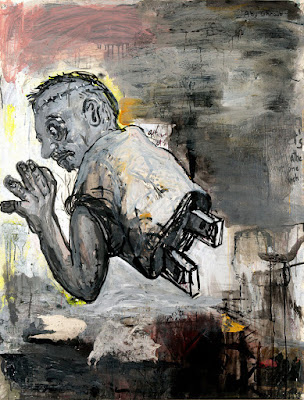Woodcut by Nomi Silverman in 440 Gallery's group show
"Personal is Political is Personal" juried by Sue Coe
The past few weeks have been an escalating nightmare across
the world and at home: the Orlando massacre, then the bombings in Istanbul and
Bangladesh followed by the police shootings in Baton Rouge and Minnesota, the
bloodbath in Dallas, then terror in Nice and the attempted coup in Turkey. When 440 Gallery chose the theme several months
ago for our summer juried group show “Personal is Political is Personal” we
were focused on the fact that it is an election year. National elections tend to magnify all sorts
of issues—from gun control to women’s rights, the criminal justice system and
the scourge of racism and bigotry. The unspoken dread was that, unfortunately,
the chances were high that by the time the show opened in summer—there would be
blood.
We are artists. What
can artists possibly do to effect change? This exhibit, juried by Sue Coe, is
one lamp lit in the darkness of despair. It is not an escapist fantasy nor a
dirge but a kindling of ideas. Some of
the work is heavy, sad or provocative but when these emotions are channeled
through the mind and hands of an artist the art object itself becomes the
reality, we are one step removed from our own trauma. We have space to breathe, to process and to
respond.
Ibn Randall’s work is commentary on race, inclusion, beauty
and judgment but these works on paper are also captivating as art: boldly
graphic, deftly drawn and technically mirroring the philosophical content of
the piece. Black text is stamped over
the images, the lettering slightly abraded like a fading billboard. The shading and half tones of black and white
imagery, a combination of exquisite drawing and screen printing, echo the struggle
to overcome the limitations of a life reduced to black and white.
Dale Williams’ paintings and drawings evoke the angst of our
times. His paintings are populated by pathetic creatures, antlike, wearing
cement shoes, wielding weapons or begging for something. These tortured souls are the descendants of
Ensor’s “Scream,” fragile humanity trapped in a hostile environment.
Divine Williams’ photograph of two young children stirs a
conversation. They are holding hand scrawled signs that say “Hands Up” and
“Justice for Mike Brown.” Are they part
of the somber Black Lives Matter march in another of William’s photographs on
view here? These two children completely
disarm the viewer with their innocent faces, smiling reflexively for the
camera.
Textiles have been featured in juried shows at 440 over the
past several years and Sue Coe has chosen some exquisite examples in this
traditionally feminine medium. Bethany
Taylor’s medieval banners depict contemporary
conflict with embroidered titles in English and Latin. Eva Capobianco’s homage to her childhood
cowgirl outfit is a tour de force of lush needlepoint that invites discourse
about our violent culture and girl-power.
Katrina Majkut uses cross stitching—a style of needlework associated with prim religious
axioms sewn by virginal young ladies-in-training to show us images of pregnancy
tests and the morning after pill.
This is a show that provokes and engages us or enrages us. It creates a space for thought, for
discussion, for hope, revulsion and empathy.
This is what artists can do to effect change: we can provide a safe
place to work all this out.






